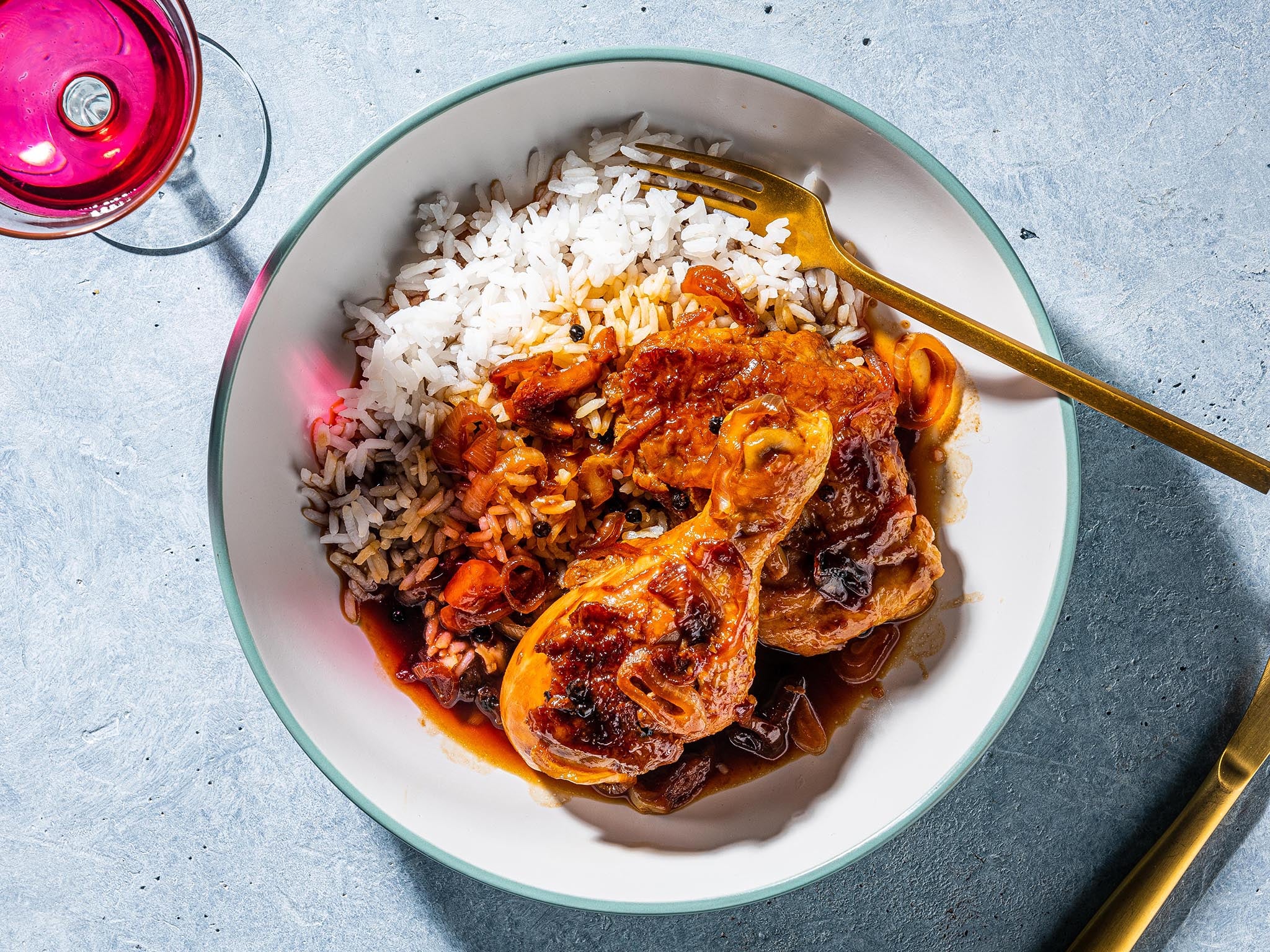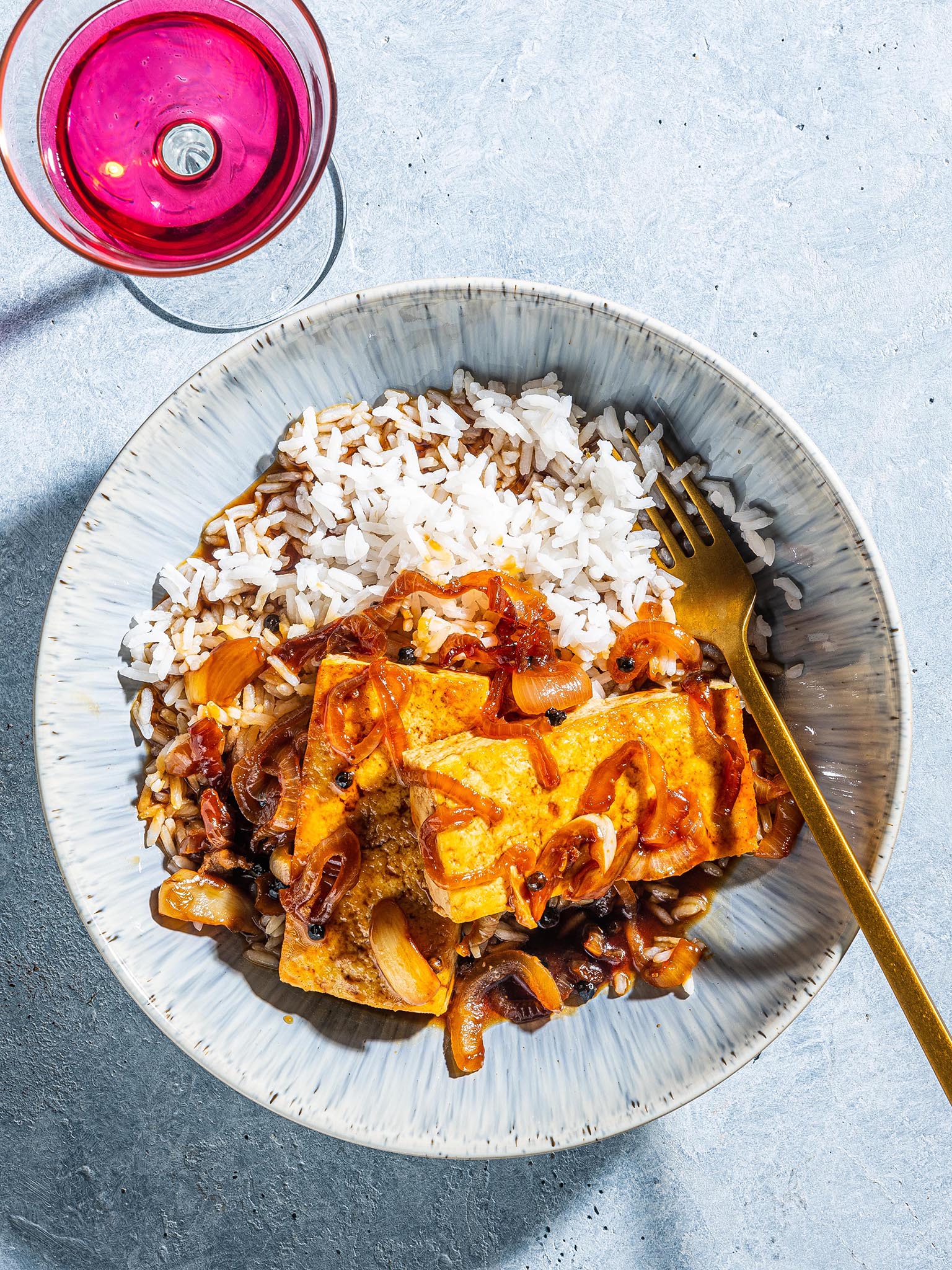Filipino adobo: A tangy, salty stew worthy of celebration
G Daniela Galarza recalls a traditional recipe from her childhood

Your support helps us to tell the story
This election is still a dead heat, according to most polls. In a fight with such wafer-thin margins, we need reporters on the ground talking to the people Trump and Harris are courting. Your support allows us to keep sending journalists to the story.
The Independent is trusted by 27 million Americans from across the entire political spectrum every month. Unlike many other quality news outlets, we choose not to lock you out of our reporting and analysis with paywalls. But quality journalism must still be paid for.
Help us keep bring these critical stories to light. Your support makes all the difference.
I had a lot of babysitters before I turned 12, women who would watch me and my brother after school, and sometimes make us dinner when my parents had to work late. Lina, who was born in Manila, was one of my favourites. Among other things, she instilled in me a love for the salty, lightly spiced tang of adobo.
Lina’s kitchen was tight, so when she started making dinner, I’d lean over the white breakfast bar and watch her rummage through her crisper drawers and pantry, lining ingredients up between the sink and stove. Almost every meal would start with an onion, which she’d pass to me to peel as she started to prep. “Every person is an onion,” she’d sometimes say, “full of hidden layers.”
Like a ballerina, Lina transitioned swiftly from precise, quick movements to calm efficiency as she cooked. I’d watch her turn on the rice cooker, add rice, oil, salt and water, and set it with a few beeps. Then, she’d put a large pot on an electric burner to start heating up as she sliced the onion into half-moons and opened a packet of chicken, usually drumsticks and thighs. They’d get seared in the pot alongside the garlic and onions. Even if I wasn’t watching her, I knew we were having adobo when the smell of vinegar and black peppercorns, heady and alive, hit the hot metal and started to tickle my nose.
Though adobo is a Spanish word, the technique for making Philippine adobo predates the centuries-long Spanish colonisation of and rule over the 7,000-island archipelago. In the Philippines, adobo is both a preparation – the process of marinating and infusing ingredients with vinegar and other flavourings – and the resulting dish. Some versions take more than a day to make; others, like the basic recipe I adapted below, can be on the table in an hour. There are probably thousands of variations – adobo can be made around any protein or vegetable; it can be wet or dry, sweet or spicy, silky or thick as soft wool – but they are united by the sour, briny punch of vinegar.
Vinegar was long employed as a preservative in the days before reliable refrigeration, so many cultures developed an affinity for the flavour. But in adobo, vinegar doesn’t sit slyly in the background – it dominates. That said, as with every great dish, a good adobo is all about balance.
“If you taste the sauce right after you add the liquids, it’ll be too tart. Over time, the sauce mellows into something slightly sour yet balanced,” writes chef Nicole Ponseca, in I Am a Filipino: And This Is How We Cook, a cookbook she wrote with Miguel Trinidad and Rachel Wharton.
“Some people add coconut milk; some cooks add a bit of sweetness in the form of sugar, honey, ripe fruit or even preserves to round out the adobo's sharp acidity and saltiness,” Ponseca writes. “Think of it like you do music: the notes are familiar, but the arrangement is what makes it unique.”
Filipino adobo

Serves: 2 to 3
Active time: 20 minutes | Total time: 1 hour
Filipino adobo, a stew known for its pungency – from vinegar, soy sauce, garlic and peppercorns or chillies – is an incredibly adaptable dish. The proportions of its key ingredients can be added in varying ratios to suit the tastes of the cook, meaning that no two adobos are exactly alike. It’s traditionally made with cane vinegar and light soy sauce; sometimes lime juice or sugar is added, as well. This version uses onions for a touch of sweetness and can be made with either chicken or tofu. If you have time, you can marinate the protein overnight, but it’s not necessary.
If adobo is unfamiliar to you, make this recipe as written before playing around with it. Here are a few suggested variations:
Instead of chicken or tofu >> you can use an equal weight of pork belly, cut into 2.5cm cubes. You also can use a whole cauliflower, cut into eight roughly equal chunks – or combine two of these options in one pot.
The onion isn’t as crucial as the garlic >> so skip it if you must. If you enjoy garlic, use more than the recipe suggests.
Cane vinegar or coconut vinegar are traditional here >> but white or rice vinegar work, too (see notes).
In addition to the onions and garlic, you could add: sliced mushrooms, chopped tomatoes or slices of fresh sweet or hot peppers.
To spice things up, consider adding: more peppercorns, a cinnamon stick, a star anise pod and/or a couple of cloves.
Notes: Wrap the tofu in a clean dish towel and microwave on high for 1 minute. Unwrap, rewrap with a fresh towel and repeat (this gets rid of excess liquid and is faster than pressing the tofu). Unwrap, and slice the tofu as directed.
If using tofu, there’s no need to season it with salt before searing.
If you don’t have cane vinegar, use white or rice vinegar plus 2 teaspoons of brown sugar. Instead of soy sauce, you can use liquid aminos. If using coconut aminos, which are sweeter, add ½ teaspoon fine sea salt or table salt, or more to taste.
Storage notes: Leftovers can be refrigerated in a covered container for up to 4 days.
Where to buy: Cane vinegar and light soy sauce can be found at Asian markets or online.
Ingredients:
680g bone-in, skin-on chicken thighs and/or legs patted dry, or 400g extra-firm tofu, drained, pressed (see notes), cut into 4 or 5 thick slices and patted dry
¼ tsp fine sea salt or table salt (optional; see notes)
2 tbsp coconut oil or vegetable oil
1 small yellow onion (115g) sliced
5 cloves garlic, lightly smashed
120ml cane vinegar (see notes)
120ml light or low-sodium soy sauce (see notes)
Water, as needed
1 tsp black peppercorns
3 bay leaves
Steamed white rice, for serving
Method:
If using chicken, season it with the salt. In a large, lidded pot or casserole dish over high heat, heat the oil until you see a few wisps of smoke. Using tongs, transfer the protein – if using chicken, skin side down – into the pot. Cook, undisturbed, until the protein has browned and the chicken skin has rendered some of its fat, 3 to 4 minutes. Turn the pieces over, and reduce the heat to low.
Add the onion and garlic, and allow the garlic to slightly brown, about 2 minutes (the onions may not be browned at this point, and that is fine). Add the vinegar, soy sauce, water, peppercorns and bay leaves, taking care as the liquid may sputter. Increase the heat to high and bring to a boil before lowering the heat to maintain a steady but gentle simmer.
Cover and cook, stirring and turning proteins over once or twice, until the chicken is cooked through or the tofu has taken on the dark color of the sauce, 30 to 40 minutes. If the liquid appears to be evaporating during cooking, add water, 120ml at a time, to compensate. The finished sauce should be thin but pungent.
Taste, and adjust the seasonings, if desired; discard the bay leaves. Spoon some rice into plates or shallow bowls and divide the stew, sauce, any rendered chicken fat and peppercorns among each dish before serving.
Nutrition information per serving (with tofu) | calories: 298; total fat: 17g; saturated fat: 9g; cholesterol: 0mg; sodium: 2,356mg; carbohydrates: 24g; dietary fibre: 1g; sugars: 15g; protein: 17g.
Per serving (with chicken)| calories: 549; total fat: 37g; saturated fat: 16g; cholesterol: 150mg; sodium: 2,119mg; carbohydrates: 23g; dietary fibre: 1g; sugars: 17g; protein: 34g.
This analysis is an estimate based on available ingredients and this preparation. It should not substitute for a dietitian’s or nutritionist’s advice.
Loosely adapted from ‘The Filipino Cookbook’ by Miki Garcia (Tuttle, 2017) and ‘I Am a Filipino’ by Nicole Ponseca and Miguel Trinidad with Rachel Wharton (Artisan, 2018).
© The Washington Post
Join our commenting forum
Join thought-provoking conversations, follow other Independent readers and see their replies
Comments